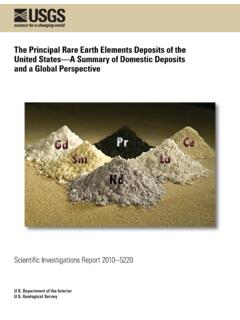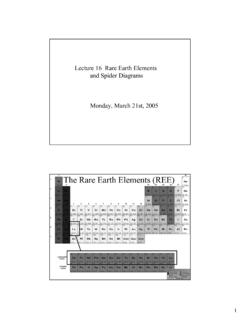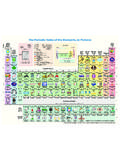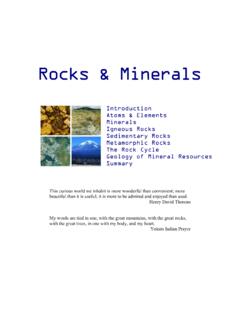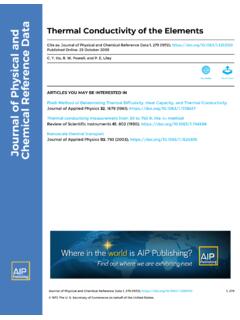Transcription of Critical Materials Rare Earths Supply Chain: A Situational ...
1 Critical Materials Rare Earths Supply Chain: A Situational White Paper April 2020 (This page intentionally left blank) iii The DOE Office of Energy Efficiency and Renewable Energy (EERE) Advanced Manufacturing Office (AMO) partners with industry, small business, universities, and other stakeholders to identify and invest in emerging technologies with the potential to create high-quality domestic manufacturing jobs and enhance the global competitiveness of the United States. Disclaimer This report was prepared as an account of work sponsored by an agency of the United States Government.
2 Neither the United States Government nor any agency thereof, nor any of their employees, makes any warranty, express or implied, or assumes any legal liability or responsibility for the accuracy, completeness, or usefulness of any information, apparatus, product, or process disclosed, or represents that its use would not infringe privately owned rights. Reference herein to any specific commercial product, process, or service by trade name, trademark, manufacturer, or otherwise, does not necessarily constitute or imply its endorsement, recommendation, or favoring by the United States Government or any agency thereof.
3 The views and opinions of authors expressed herein do not necessarily state or reflect those of the United States Government or any agency Materials Rare Earths Supply Chain: A Situational White Paper iv Table of Contents Introduction .. 1 The Department of Energy s Role .. 2 Strategic Response .. 3 Key Takeaways .. 4 Status of the Industry .. 5 Background .. 5 Mining .. 6 Concentration .. 6 Separation & 7 Magnet Manufacturing .. 8 Recycling .. 8 Challenges .. 8 Permitting .. 8 Technology Transfer .. 8 Market .. 9 Workforce Development .. 10 Opportunities.
4 10 Innovation Ecosystem .. 10 R&D Solutions .. 10 Cross-cutting Themes .. 10 Characterization, Mining, and Concentration .. 11 Separation and Processing .. 11 Magnet Manufacturing .. 11 Supply Chain Development .. 12 Next Steps .. 12 List of Acronyms .. 13 Critical Materials Rare Earths Supply Chain: A Situational White Paper v List of Figures Figure 1. Methodology for Critical Mineral Determination .. 1 Figure 2. Summary of Supply Chain Challenges and Opportunities .. 5 Figure 3. Rare earth 5 Figure 4. Rare earth Element Supply Chain for Neodymium Iron Boron Magnets.
5 6 Critical Materials Rare Earths Supply Chain: A Situational White Paper 1 Introduction The assured Supply of Critical Materials and the resiliency of their Supply chains are essential to the economic prosperity and national defense of the United States. The manufacturing and deployment of these goods provides employment for American workers and contributes to economic growth. The United States is dependent on foreign sources of Critical Materials . Building on a determination methodology1 (see Figure 1), of the 35 minerals or mineral material groups identified as Critical in the list2 published in the Federal Register by the Secretary of the Interior, the nation is 100% net import reliant for 143 and is more than 50% import-reliant for 17 of the remaining 29 mineral This import dependence is a problem when it puts Supply chains and companies and material users at risk.
6 Many foreign sources of Critical Materials are concentrated in just one or two countries. For example, 60% of the world s cobalt is mined in the Democratic of Congo, and 80% of that Supply is processed in The dependency of the nation on foreign sources of Critical Materials creates a strategic vulnerability for both our economy and our military with respect to adverse foreign government actions, natural disasters, and other events that could disrupt Supply . To address this problem and reduce the Nation s vulnerability to disruptions in the Supply of Critical minerals, President Donald J.
7 Trump issued Executive Order (EO) 13817, A Federal Strategy to Ensure Secure and Reliable Supplies of Critical Minerals,6 on December 20, 2017. The EO directs the Secretary of Commerce, in coordination with heads of selected executive branch agencies and offices, to submit a report to the President that includes: I. a strategy to reduce the Nation s reliance on Critical minerals; 1 Fortier et al. Draft Critical Mineral List Summary of Methodology and Background Information Geological Survey Technical Input Document in Response to Secretarial Order No.
8 3359. Geological Survey. 2018. Available online at: 2 Aluminum (bauxite), antimony, arsenic, barite, beryllium, bismuth, cesium, chromium, cobalt, fluorspar, gallium, germanium, graphite (natural), hafnium, helium, indium, lithium, magnesium, manganese, niobium, platinum group metals, potash, rare earth elements group, rhenium, rubidium, scandium, strontium, tantalum, tellurium, tin, titanium, tungsten, uranium, vanadium, and zirconium. 3 Mineral Commodity Summaries 2020. Geological Survey. 2020. Available online at: 4 Final List of Critical Minerals 2018, Department of the Interior.
9 83 Fed. Reg. 23295; 2018. Available online at: 5 Supra 3. Mineral Commodity Summaries 2020. Geological Survey. 2020. 6 Executive Order 13817. Executive Office of the President. December 2017. Available online at: Figure 1. Methodology for Critical Mineral Determination Critical Mineral* i. A non-fuel mineral or mineral material essential to the economic and national security of the United States; ii. the Supply chain of which is vulnerable to disruption; and iii. that serves an essential function in the manufacturing of a product, the absence of which would have significant consequences for our economy or our national security.
10 * Definition in EO Critical Materials Rare Earths Supply Chain: A Situational White Paper 2 II. an assessment of progress toward developing Critical minerals recycling and reprocessing technologies, and technological alternatives to Critical minerals; III. options for accessing and developing Critical minerals through investment and trade with our allies and partners; IV. a plan to improve the topographic, geologic, and geophysical mapping of the United States and make the resulting data and metadata electronically accessible, to the extent permitted by law and subject to appropriate limitations for purposes of privacy and security, to support private sector mineral exploration of Critical minerals; and V.











